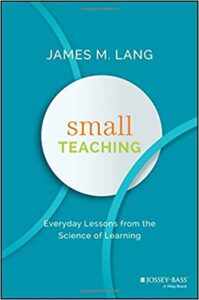This post is by Asif Devji.
BIG IDEA:The goal of instructors should be to help learners “forge rich, interconnected networks of knowledge – ones that enable each existing piece of information in our content area to connect with lots of other information, concepts and ideas.
INTRODUCTION
With Chapter 4 we move into Part II of Small Teaching, which shifts the focus from helping learners acquire knowledge to helping them develop a deeper understanding of their knowledge base by building on complex cognitive skills.

Photo by Alexander Pogorelsky on Unsplash
In his introduction to Part II: Understanding, Lang refers to the flipped classroom model to make the point that such active learning approaches aimed at strengthening learner comprehension need to be undertaken “deliberately, with eyes wide open, and with the help of the literature on human learning” if they are to be effective.
Chapter 4: Connecting begins with an image of ‘small disconnected islets’ – bits of knowledge representing the “disparate sets of concepts or skills” that learners acquire as they “absorb the knowledge from each lecture in a course without connecting the information to other lectures or recognizing themes that cut across the course.”
These scattered bits of knowledge aren’t very meaningful; learners “lack comprehension…because they lack connections.” The goal of instructors should be to help learners “forge rich, interconnected networks of knowledge – ones that enable each existing piece of information in our content area to connect with lots of other information, concepts and ideas.”
IN THEORY
The “link between making connections and building comprehension” is biological. In our brains “neurons form new connections with other neurons with every new experience we have,” and learning generates “the continual formation of connections between our neurons.”
When sets of connected neurons repeatedly “fire together” they carve out distinct pathways that connect to form networks. “The knowledge in our minds consists of neuronal networks in our brains.” Deep reflection on a piece of acquired knowledge connects it to other neuronal networks, “until it eventually sits at the heart of a dense weave of connections – what we normally think about as understanding or comprehension.”
The task of instructors is to “create an environment that facilitates the formation of those connections” and to help “expand those connections into networks that enable students to see the bigger picture, make meaning, apply what they have learned into novel contexts.”
If we are successful, learners can move from being novices towards being experts in our content areas. When an expert “encounter[s] a new piece of information or a new idea in their field of expertise, they immediately slot it into a fully developed network that enables them to see connections between it and dozens of other things they know.”
MODELS
Lang offers four strategies “to help students modify and enhance their connections.” These can be applied “at any point during the semester or during any class period” to help learners “forge connections within a semester’s worth of material.”
1/ What do You Already Know (and What do You Want to Know?)
“Prior knowledge plays a critical role in learning.” Newly learned material will connect with what a learner already knows (or thinks they know) about a subject. Instructors should have students make “individual and collective knowledge dumps, telling you everything they know” about your subject. This will allow the instructor not only to “recognize and correct mistaken perceptions” but also to “activate whatever knowledge they currently have that you want to build on or reinforce.”
2/ Provide the Framework
Providing learners with an “organizing framework” of the material to be covered in a course and then having them fill in the details helps them to “build accurate connections” that will improve their conceptual understanding of the content. The framework should be a “skeletal outline” – just headings and titles of concepts – with students fleshing out the document themselves. Learners will “connect most deeply” if provided with a “frame of a knowledge network” rather than an already completed network or if left to “devise the organizational principles of the material on their own”
3/ Concept Maps
A concept map is a “visual representation of a knowledge domain” and concept mapping activities can be used to help students “visualize the organization of key ideas in your course.” Learners can be asked to construct a concept map of the course material, with “key concepts” in the center and lines branching off to “subsidiary elements.” The branching lines can then be labeled to define the relationships between the elements. Having learners make multiple maps integrating the same concepts based on different organizing principles can give them practice in “organizing their knowledge according to alternative schemata or hierarchies” and thereby build “more robust and flexible knowledge organizations.”
4/ Minute Thesis
The Minute Thesis is an activity that helps learners “solidify existing connections” and “envision new ones.” Students are asked to “set up columns or categories of essential course concepts or texts, connect them in new and creative ways,” and then develop an impromptu thesis to describe “how or why those connections make sense.” The activity provides a familiar “scaffolding through the columns or categories” but then asks learners to make a leap and “forge connections between things that have not been connected before.” These “creative connections” help them to generate new and original thinking around the course content.
PRINCIPLES
The strategies above are meant to “provide a bridge between your expert comprehension of your subject matter and the novice understanding of your students.” Facilitating the building of their connections will help your learners move towards your “big-picture view” of the material.
Provide the Framework: You should be transparent about your expertly networked knowledge by “making the framework as visible as possible, pointing back to it frequently, and helping them recognize where new material fits into the frame.”
Facilitate Connections: You should also “open the space” for learners to form their own unique connections and “see unexpected juxtapositions, chart new pathways…or invent their own knowledge networks.” Your presence as an expert to “provide feedback on their discoveries and help nudge them in productive new directions” can support them in developing their expertise.
Leverage Peer Learning Power: Because your students “all share the position of being novice learners in your field,” you should encourage them to help each other to co-create connections. By facilitating collaborative activities in which learners can “consider the connections made by their peers” you can spark their “energy and curiosity” without the weight of expert expectations.
QUESTIONS
Does any of the above raise any questions for you in terms of application in a real-world classroom?
Please discuss in this week’s forum: Chp. 4: Connecting and join us for the live web conference meetup on Friday, October 4th at 11:00am.
See How to Participate.




 Small Teaching is “an approach that seeks to spark positive change in higher education through small but powerful modifications to our course design and teaching strategies”
Small Teaching is “an approach that seeks to spark positive change in higher education through small but powerful modifications to our course design and teaching strategies” 